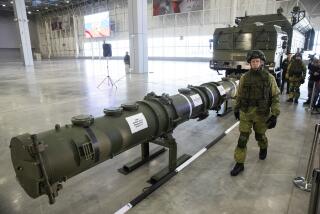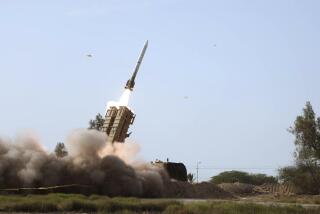Analysis : SALT III Prospects Hinge on U.S. Response to New Soviet Offer
WASHINGTON — The latest round of the Geneva arms talks, which ended last week in Geneva, created the greatest pressure yet on the Reagan Administration to address seriously the prospect of reaching a SALT III arms agreement with the Soviet Union.
How the Administration responds to significant new proposals made by the Soviets will probably determine whether it will leave a legacy of real arms reduction or a vacuum in which a new arms race could erupt.
Moreover, it could well make or break prospects for the expected summit in the United States later this year between President Reagan and Soviet leader Mikhail S. Gorbachev. If there is such a meeting, it is likely to affect the course of U.S.-Soviet relations for at least the rest of the Reagan Administration.
To some knowledgeable officials, the President’s decision on when and how to respond to the Soviet proposals will cause more rancor within the Administration, and be more far-reaching for the world, than his decision to stop abiding by the second strategic arms limitation treaty (SALT II).
‘Constructive Response’
In Geneva, Max M. Kampelman, the chief U.S. negotiator, promised a “constructive response” to the Soviet proposals to advance the prospects for such an accord, but this will be much more difficult to devise than the phrase suggests.
Even before the Soviet proposals were fully absorbed, disputes broke out within the Administration on how soon to make the counterproposal.
Conservatives counsel delay until the next round opens in three months’ time, to ensure careful scrutiny of any hidden traps in the Soviet offer. Moderates want an earlier response to keep up the momentum.
To a considerable degree, Soviet complaints about U.S. foot-dragging at Geneva are valid, U.S. officials acknowledge, for without making any concessions, President Reagan has achieved significant movement in the Soviet positions.
But to fashion a reasonable counteroffer, he will have to make difficult military and political decisions, some of which were outlined in interviews here and abroad with U.S. officials, congressmen and other authoritative sources.
Decision on Linkage
The most important of these decisions will be whether to accept the linkage between offensive missiles and space-based defenses that the Soviets have proposed, or to continue to insist that the two issues are separate and unrelated.
In their offer, spread over the past month, the Soviets proposed a 33% cut in offensive nuclear missiles and bombers if the United States would agree in effect to pledge not to deploy a Strategic Defense Initiative system--popularly known as “Star Wars”--for 15 or 20 years.
Reagan will also have to decide whether to hold the Kremlin to its original promise to cut offensive arms by 50%, according to various sources, or to move away from that figure.
He will be tempted to regain some of the propaganda advantage now enjoyed by the Soviets by insisting on the 50% figure but will also insist on deeper cuts in at least some of the most threatening offensive weapons systems--land-based intercontinental ballistic missiles (ICBMs)--to prevent an outcome, now built into the Soviet proposal, that would allow Moscow to retain an advantage in “first-strike,” or surprise attack, warheads.
Both the United States and the Soviets last year proposed 50% cuts in strategic weapons, although the two sides differed on the kind of weapons to be included in the overall arsenal on which the reductions would be calculated.
Conflicting Proposals
Specifically, the Soviets insisted on counting U.S. medium-range weapons in Europe and Asia and aboard aircraft carriers. The United States proposed cuts only in weapons systems capable of traveling intercontinental distances of 3,000 miles or more.
Now the Soviets have dropped their demand to include U.S. medium-range systems, a move welcomed by U.S. officials as clearing away a key obstacle to accord.
But to compensate, the Soviets also proposed to reduce the arsenals by only about 33%. Reagan can obviously get political mileage out of challenging the Soviets to stay with their original offer, an offer to which Gorbachev committed himself personally at last November’s meeting with Reagan in Geneva.
But if agreement is to be achieved, some officials argue, the reduction percentage will probably lie somewhere between the two figures. So rather than emphasize 50%, when he is likely to accept something less later, the President will be advised by some officials to forgo the short-term propaganda gain.
Instead, he will be urged to attack the larger problem of seeking stability between the superpowers when both are left with 8,000 or so “nuclear charges,” as the Soviets have proposed.
Would Count the Same
The Soviets created this issue by proposing to treat as equal all kinds of “nuclear charges.” In their scheme, a warhead on a fast-flying, invulnerable ballistic missile would count as much as a gravity bomb on a slow-flying B-52 bomber or cruise missile, against which the Soviets have built extensive air defenses.
This would put the United States, with its far greater arsenal of bombers and cruise missiles, at an unacceptably great disadvantage, one source said.
So would the Soviet proposal that would permit the Kremlin to keep 4,800 warheads on land-based ballistic missiles. This would allow the Soviets to hit all key U.S. targets--missile silos, command posts, communication centers--in a surprise attack with three ICBM warheads each.
The Reagan counterproposal can also be expected to insist on establishing at least a hierarchy of sub-systems that would drastically limit the number of ICBM warheads permitted in each arsenal, particularly on the gigantic Soviet SS-18 missiles, each of which carries 10 warheads.
Similarly, the United States welcomed the new Soviet proposal that dropped Moscow’s previous demand for a ban on long-range air- and submarine-launched cruise missiles.
Crippling Navy’s Plans
But the Soviets at the same time want to ban cruise missiles from surface ships and would count all cruise missiles as if they had nuclear warheads. This would cripple the Navy’s cruise missile plans, which call for deploying 4,000 of them, for the most part on surface ships.
Moreover, 80% of the cruise missiles would be equipped with conventional warheads, for anti-ship use, but they would be counted as having nuclear warheads targeted against the Soviet homeland.
Reagan is certain to reject that provision, much as he is sure to balk at Soviet efforts to restrict the “Star Wars” program to the research phase.
The new Soviet proposal, for the first time, drops earlier demands for a total ban on all Strategic Defense Initiative work, including basic research. This would prohibit even “proof of concept” tests on a small scale, like those planned for later in this decade at White Sands, N.M.
The President is certain to face criticism from hard-liners in his Administration if he accedes to this proposal, since it will abort the “Star Wars” effort well before its grand promise of making offensive missiles “impotent and obsolete.”
Alternative Needed
But much as with offensive weapons, Reagan must come up with an alternative to the Soviet proposals if the negotiation process is to maintain its momentum.
A knottier political problem faces Reagan regarding the Anti-Ballistic Missile (ABM) Treaty. This difficulty arises because of the language of the ABM treaty. It effectively forbids deployment of anti-missile defenses, with an escape clause that permits either side to break out of the treaty six months after serving notice that “extraordinary events” had occurred to adversely affect its “supreme national interest.”
The Soviets want that “non-withdrawal” clause to be extended from six months to 15 or 20 years. They have privately hinted that 10 years would be an acceptable extension. But even two years may be the maximum, and there are doubts that even that could be achieved.
To forswear defense of the “supreme national interest” in this rapidly changing technological world, for even a few years, would likely provoke a bitter ideological fight within the Republican Party, particularly since the Administration insists that the Soviets are violating the same ABM treaty that would be extended.
If the President chooses to circumscribe his “Star Wars” program for any period, as the price for deep cuts in offensive arms, it will probably be necessary to find some political device other than a direct extension of the non-withdrawal clause.
Issue of Verification
Finally, the President will have to address the issue of how to verify any new agreement. The Soviets were also forthcoming on verification possibilities, although less so than in other areas.
They suggested monitoring mobile intercontinental missiles, much as the United States had proposed monitoring medium-range mobile missiles--by counting them as they leave factories, by limiting their deployment to certain areas and possibly by marking their transport vehicles with distinguishing features.
At this point, the U.S. proposal calls for a ban on all long-range mobile missiles, but with the Soviets now deploying one new type of mobile ICBM and preparing to deploy a second new type, and with the Pentagon deep in design studies of its own mobile missile, it is probably only a matter of time before the Administration scuttles the idea of a ban and seriously addresses the verification issue in responding to the Soviet proposal.
More to Read
Get the L.A. Times Politics newsletter
Deeply reported insights into legislation, politics and policy from Sacramento, Washington and beyond. In your inbox three times per week.
You may occasionally receive promotional content from the Los Angeles Times.










